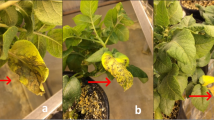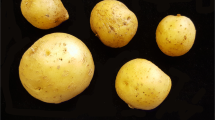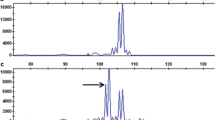Summary
Katahdin potatoes did not become infected with virus A during 2 years field exposure in which 49% ofGreen Mountain were infected. In the greenhouse,Katahdin plants were not infected by aphids at any stage of plant development, and they were resistant but not immune to virus A from sap inoculation.
Katahdin plants were readily infected with virus A by grafting, but unlike the hypersensitiveIrish Cobbler, Katahdin reacted like those of susceptible varieties — practically symptomless to virus A alone, but with a mosaic when virus X was also present. Despite the apparent superticial nature of the resistance, several tests failed to show any “inhibitor” in the surface tissues ofKatahdin. Aphids feeding on chlorophyll-free sprouts developed in the dark or on stem tissues beneath stripped-off epidermis did not cause infections. Aphids already carrying virus A probed intoKatahdin leaves without losing the ability to infectNicandra physaloides. And virus free aphids could acquire virus A from leaves of graft-in-fectedKatahdin as readily as from “susceptible” varieties.
Zusammenfassung
Die KartoffelsorteKatahdin war nach einem 2-jährigen Feldanbau nicht mit A-Virus infiziert, während 49% der SorteGreen Mountain erkrankte. In Gewächshausversuchen konnten Pflanzen der SorteKatahdin in keinem Entwicklungsstadium durch Blattläuse infiziert werden. Diese Sorte ist resistent aber nicht immun gegenüber mechanischer Safteinreibung.
Pfropfungsübertragung war stets erfolgreich; in Gegensatz zur überempfindlichen SorteIrish Cobbler reagierteKatahdin jedoch auf die Infektion mit A-Virus ebenso wie anfällige Sorten, d.h. praktisch ohne Symptome, jedoch mit Mosaiksymptomen in der Gegenwart von X-Virus. Trotz des oberflächlichen Charakters dieser Resistenz konnte in keinem Versuch ein “Hemmstoff” in den oberen Zelllagen der Pflanzen nachgewiesen werden.
Blattläuse, die auf im Dunkeln gewachsenen Chlorophyll-freien Sprossen oder auf Stengeln deren Epidermis entfernt war saugten, konnten keine Pflanzen infizieren. A-Virus tragende Blattläuse bohrtenKatahdin Blätter an ohne das Vermögen zu verlieren anschliessendNicandra physaloides zu infizieren. Gleichfalls, konnten virusfreie Blattläuse A-Virus aus durch Pfropfung infiziertenKatahdin Pflanzen ebenso aufnehmen wie aus “anfälligen” Sorten.
Résumé
Dans une culture de la variétéKatahdin effectuéc pendant deux ans d'exposition en plein champ à l'infection, aucune infection par le virus A ne fut observée, tandis que l'infection était de 49% dans la variétéGreen Mountain cultivéc dans les mêmes conditions. En serre, les plantesKatahdin ne furent infectées par les pucerons à aucun stade de développement des plantes et il fut observé qu'elles étaient résistantes, mais non immunes à l'inoculation par le jus infectieux au virus A.
Les plantesKatahdin étaient aisément infectables par le virus A par greffe, mais leur réaction n'était pas comparable à celle des plantes de la variété hypersensitiveIrish Cobbler. La réaction des plantesKatahdin était égale à celle des variétés susceptibles. c'est-à-dire qu'elles ne présentaient pratiquement aucun symptôme après infection par le virus A seul, mais si celui-ci était accompagné du virus X, il apparaissait une mosaïque. Bien que la résistance semble être superficielle, les résultats de plusieurs tests ne révèlent aucun effet d'un élément “inhibiteur” dans les tissus superficiels.
Des pucerons porteurs du virus A, suçant les tiges dont l'épiderme était ou les germes de tubercules germés à l'obscurité, et de ce fait ne contenant pas de chlorophylle, ne causaient aucune infection. Des pucerons porteurs du virus sondaient les feuilles deKatahdin sans perdre leur faculté d'infecter plus tard des plantes deNicandra physaloides. Les pucerons non-porteurs du virus pouvaient être infectés par le virus A en suçant les feuilles d'uneKatahdin infectéc par greffe aussi bien qu'à partir de variétés “susceptibles”.
Similar content being viewed by others
References
Adams, J. B. (1946): Aphid resistance in potatoes.Amer. Potato J. 23, 1–22.
Akeley, R. V., F. J. Stevenson &E. S. Schultz (1948): Kennebec: A new potato variety resistant to late blight, mild mosaic, and net necrosis.Amer. Potato J. 25, 351–361.
Bagnall, R. H. (1961): Hypersensitivity to viruses A and X in Canadian and American potatoes. (In Press).
Bradley, R. H. E. (1954): Studies of the mechanism of transmission of potato virus Y by the green peach aphidMyzus persicae Sulz. (Homoptera: Aphidae).Can. J. Zool. 32, 64–73.
Bradley, R. H. E. (1956): Effects of depth of stylet penetration on aphid transmission of potato virus Y.Can. J. Microbiol. 2, 537–547.
— (1959): Loss of virus from the stylets of aphids.Virology.8, 308–318.
Cockerham, G. (1943): The reactions of potato varieties to viruses X, A, B, and C.Ann. Appl. Biol. 30, 338–344.
MacLachlan, D. S., R. H. Larson & J. C. Walker (1953): Strain interrelationships in potato virus A.Wisconsin Univ. Agr. Expt. Sta. Research Bull. No. 180, 36 pp.
Schultz, E. S., C. F. Clark, R. Bonde, W. P. Raleigh &F. J. Stevenson (1934): Resistance of potato to mosaic and other virus diseases.Phytopathology.24, 116–132.
Simpson, G. W. &C. L. Hovey (1944): Genetic resistance to insect injury in potatoes.Maine Agr. Expt. Sta. Bull. No. 42, 224–225.
Stevenson, F. J. (1947): New varieties of potatoes.Amer. Potato J. 24, 247–260.
Stevenson, F. J., &R. V. Akeley (1953): Control of potato diseases by disease resistance.Phytopathology.43, 245–253.
Author information
Authors and Affiliations
Additional information
Contribution No. 40 Research Station Fredericton, New Brunswick.
Rights and permissions
About this article
Cite this article
Bagnall, R.H., Mackinnon, J.P. Resistance to potato virus a in theKatahdin variety. Europ. Potato J. 3, 331–336 (1960). https://doi.org/10.1007/BF02365603
Received:
Published:
Issue Date:
DOI: https://doi.org/10.1007/BF02365603




